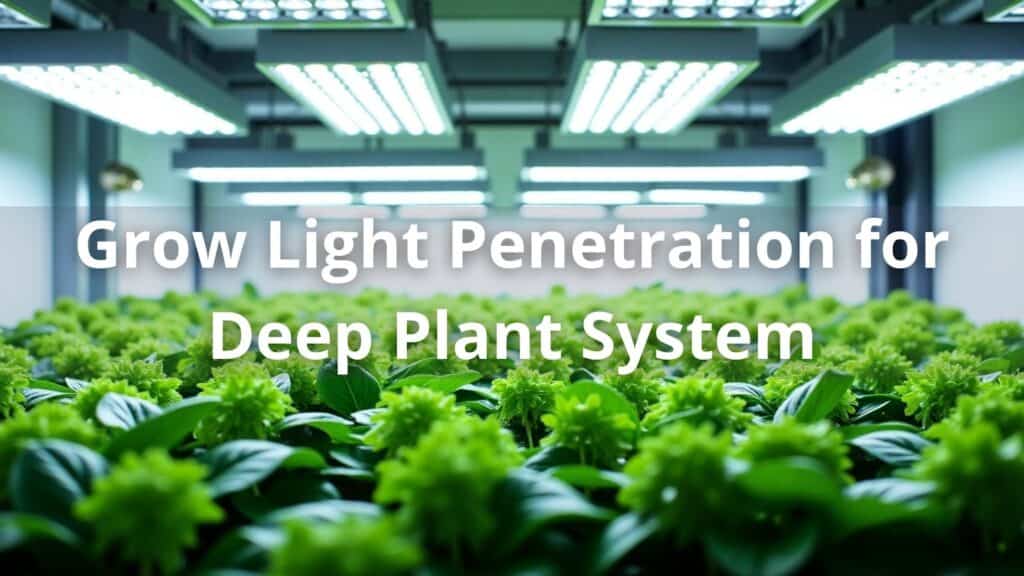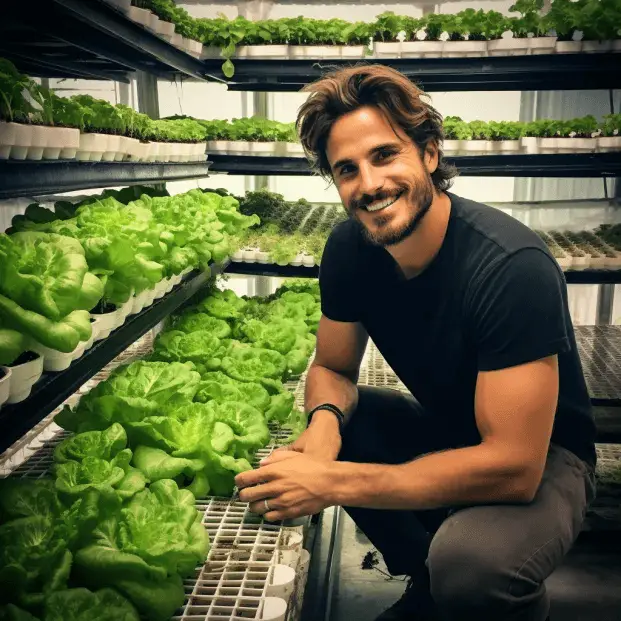Growing plants can be like a big puzzle, especially when those plants are all packed together in a deep system. You want to make sure that every leaf gets enough light, but how do you do that? This article dives into grow light penetration for deep systems, which is super important for plant health. Keep reading to find out how to make your plants thrive!
Key Takeaway
- Light penetration depends on canopy density and light intensity.
- Using LED lights can help plants get the right light they need.
- Adjusting light distance and spectrum can boost your plant’s growth.
Canopy Density and Light Penetration

Canopy density is just a fancy way of saying how thick or crowded the leaves of a plant are. Picture a big, bushy plant—light struggles to reach the lower leaves. That’s a problem. If the canopy is too dense, the bottom layers miss out on the good stuff.
A few tricks help. First, spacing. A 4×4 ft setup might work, depending on the plant. Too close, and leaves block light. Too far, and space gets wasted. Second, trimming. Cutting back excess leaves opens paths for light to sneak through. And finally, leaf orientation. Some leaves naturally tilt towards the light, others block it—angling them right makes a big difference.
Higher light intensity matters too. A strong source (like red LEDs) pushes light deeper into the green jungle. More light below means healthier plants that’s how pretty much grow light penetration for deep plant system work. So, spacing, trimming, and the right light—those make all the difference.
Light Spectrum’s Impact
Plants thrive in light. Red and blue light are big deals. Red (around 660 nanometers) makes flowers bloom. Blue (about 450 nanometers) helps stems grow strong. Together, they shape a plant’s life.
Mixing colors works best. Different wavelengths cut through leaves in surprising ways. Red? That’s for flowers. Blue? Helps plants stretch toward the sky. Simple, but powerful.
Some growers add UV light. It’s less common, but useful. UV can give plants a boost at key growth stages. Not a must-have, but an extra tool in the box.
A mix of light colors keeps plants strong. A little planning, the right setup, and plants get exactly what they need. Smart lighting makes all the difference.
Techniques for Better Light Penetration
Light plays a big role in how plants grow. One neat trick is called diffuse light penetration. This method scatters light, helping every part of the plant soak it up (1). Companies like SANlight make special lights that mimic natural sunlight, which is pretty cool.
Another interesting thing is spectral optimization. This means adding green light to the mix. Green light helps push light deeper into the leaves, which is fascinating. It might sound simple, but it can really make a difference.
Positioning LED lights is also important. The PAR map shows how light spreads over the growing area. It’s crucial for the light to hit all the plant canopies evenly. If someone wants to go a bit fancy, they could try the IONBOARD S44. It has smart algorithms to help with light placement.
So, for anyone wanting to boost their plants’ growth, using these tricks can probably help a lot. A little creativity in lighting goes a long way for happy plants.
Distance Matters

The distance between lights and plants matters a lot. If the lights are too far away, they won’t be strong enough to reach those lower leaves. But if they’re too close, plants might get burned. A good rule of thumb is to keep LED lights about 12 to 36 inches from the plant canopy.
Plants have different needs at different stages. For example, seedlings usually need less light. In contrast, flowering plants crave more. Adjusting the light distance is key as they grow. It’s like moving your reading lamp closer or farther away to see your book better.
This small change can help plants thrive. Keeping an eye on how light affects growth can help make sure they stay healthy and happy. So, for anyone growing plants indoors, remembering to check that distance is a smart move. A little attention can lead to big results in plant health.
High Humidity Environments
Growing plants in a high humidity space can be tricky. Moisture can create problems for lights. It’s important to choose lights that are moisture-resistant or even waterproof. The IONBOARD S44 is a great example of a light that can withstand wet conditions.
When lights penetrate well in humid environments, it helps keep plants healthy. This setup reduces the risk of mold and diseases. No one wants those nasty issues ruining their plants!
Choosing the right equipment is key. It might seem like a small detail, but it can make a big difference in plant health. So, for anyone growing in humid areas, being smart about lighting choices can really pay off. Happy plants lead to a happy gardener.
Key Statistics and Facts
Credits: MIGRO
Light Penetration Basics
The sun doesn’t reach the forest floor. Neither does artificial light in a grow room. Depth matters. For LEDs, 18-24 inches is the sweet spot (sometimes less for bushy strains). Canopy management trims the fat—prune those top leaves, let the bottom ones breathe. Light scatters like gossip in a small town. The lower leaves hunger for crumbs.
Green light’s sneaky. Slips past chlorophyll guards where red and blue get caught. Sieve effect, they call it. Less absorption, more travel. Think of it as light playing hide-and-seek in the leaves. Not all that glitters is gold—green’s useful but can’t replace the heavy lifters.
Height & Spread
Lights hung high cast wider nets. Dense canopies (looking at you, indica hybrids) need room to share the wealth. Trade intensity for reach. A foot higher might save a shadowed branch.
Color’s Role
Red and blue drive photosynthesis (2). Green’s the scout, mapping deeper tissue. Grow lights play favorites—seedlings get blue, flowering leans red. Green? It’s the backup singer, harmonizing but never solo.
LEDs vs. HID
LEDs pack more photons per watt. Efficiency’s their brand. HIDs punch through canopies better (sometimes). But a top-shelf LED? Brighter, cooler, cheaper long-term. You get what you pay for—budget lights breed weak stems.
Adjust. Measure. Repeat. Plants don’t care about specs, just results.
Unique Facts
Light has some surprising effects on plant growth. For instance, green light can be very efficient. At high intensities, like around 300 μmol/m²/s, green light might even outperform red light in driving photosynthesis deeper into the leaf tissue (3). That’s pretty cool!
Then there’s far red light. While it doesn’t work well on its own (it’s over 680 nm), it can actually boost photosynthesis when mixed with PAR light (400-700 nm). This is known as the Emerson effect. So, combining different light types can truly enhance plant growth.
It’s also important to know that increasing light intensity doesn’t always mean light penetrates deeper into the canopy. Instead, it just increases the total number of photons available for absorption.
For anyone growing plants, understanding these light nuances can lead to better growth. Mixing light types and knowing how intensity works can help create the best environment for plants. A little knowledge goes a long way in helping plants thrive.
FAQ
How do I measure if my plants are getting enough light?
Use PAR meter readings to measure photosynthetic photon flux density (PPFD). This measurement tells you the light intensity reaching your plants. Understanding light saturation points helps prevent photoinhibition. Different plants have varying needs, so monitoring quantum yield helps optimize growth.
Why does distance matter in indoor plant lighting?
Distance from canopy affects light intensity gradient and light distribution patterns. Grow light placement needs careful consideration – too close risks light stress, too far reduces photosynthetic yield. Light penetration depth matters when arranging your growing space.
How can I optimize my indoor growing setup?
Focus on spectral balance and light quality effects. Consider vertical farming lighting techniques and ensure proper side wall reflectivity. Energy cost efficiency matters – look for energy efficient lighting solutions that provide good spectrum customization while supporting sustainable lighting practices.
What happens inside plants when they receive light?
Light triggers phytochrome activation and cryptochrome response, controlling hormonal regulation. These processes drive chlorophyll production and enhance photosynthesis. Plant growth stimulation depends on proper photoperiodic control and circadian rhythm patterns.
How do modern grow lights compare to traditional options?
LED grow light technology offers better energy efficiency and spectrum customization than older systems. LED bar lighting and multipoint lighting provide more even coverage than central lighting. Consider environmental impact when choosing between options for hydroponic system lighting or aeroponic lighting needs.
Conclusion
In wrapping up, understanding how light penetrates deep systems is super important for plant health. By considering factors like canopy density, light spectrum, and plant spacing, you can make sure your plants get the light they need. Using techniques like diffuse light penetration and optimizing distances will help you grow healthier plants and maximize yield. Remember, happy plants equal happy growers!
References
- https://pmc.ncbi.nlm.nih.gov/articles/PMC4389658/
- https://pmc.ncbi.nlm.nih.gov/articles/PMC11040151/
- https://pubmed.ncbi.nlm.nih.gov/33747002/
Related Articles
- https://tophydroponicgarden.com/category/hydroponic-systems/deep-water-culture/deep-water-culture-deep-water-culture/
- https://tophydroponicgarden.com/how-to-increase-light-intensity-for-hydroponic-systems/
- https://tophydroponicgarden.com/grow-lights-for-high-humidity-environments/
Was this helpful?

I’m Barrie L., a passionate hydroponic gardening enthusiast dedicated to cultivating thriving, soil-less gardens. With a focus on all things hydroponic, I share my expertise on innovative growing techniques and sustainable practices through my blog, tophydroponicgarden.com. As a seasoned hydroponics specialist, my goal is to inspire and guide fellow gardeners in harnessing the power of water-based cultivation for bountiful and eco-friendly harvests. I’m also an author of the book “Hydroponics For Absolute Beginners: Your Step By Step Guide For How To Create An Hydroponics System At Home Without Soil, For Growing Vegetable, Fruit And Herbs.” which is sold on Amazon. Join me on a journey of redefining the way we cultivate plants, one nutrient-rich solution at a time. Happy growing!


